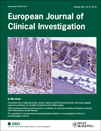Metastatic pheochromocytoma: Does the size and age matter?
Abstract
Eur J Clin Invest 2011; 41 (10): 1121–1128
Background Pheochromocytomas are tumours arising from chromaffin tissue located in the adrenal medulla associated with typical symptoms and signs which may occasionally develop metastases, which are defined as the presence of tumour cells at sites where these cells are not found. This retrospective analysis was focused on clinical, genetic and histopathologic characteristics of primary metastatic versus primary benign pheochromocytomas.
Materials and methods We identified 41 subjects with metastatic pheochromocytoma and 108 subjects with apparently benign pheochromocytoma. We assessed dimension and biochemical profile of the primary tumour, age at presentation and time to develop metastases.
Results Subjects with metastatic pheochromocytoma presented at a significantly younger age (41·4 ± 14·7 vs. 50·2 ± 13·7 years; P < 0·001) with larger primary tumours (8·38 ± 3·27 vs. 6·18 ± 2·75 cm; P < 0·001) and secreted more frequently norepinephrine (95·1% vs. 83·3%; P = 0·046) compared to subjects with apparently benign pheochromocytomas. No significant differences were found in the incidence of genetic mutations in both groups of subjects (25·7% in the metastatic group and 14·7% in the benign group; P = 0·13). From available histopathologic markers of potential malignancy, only necrosis occurred more frequently in subjects with metastatic pheochromocytoma (27·6% vs. 0%; P < 0·001). The median time to develop metastases was 3·6 years with the longest interval 24 years.
Conclusions In conclusion, regardless of a genetic background, the size of a primary pheochromocytoma and age of its first presentation are two independent risk factors associated with the development of metastatic disease.




